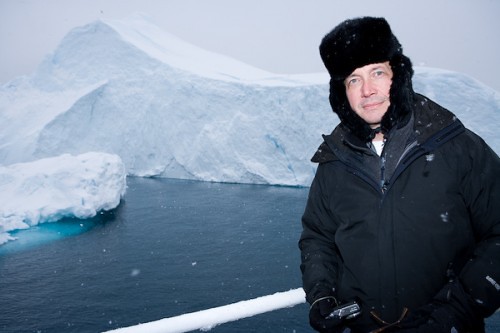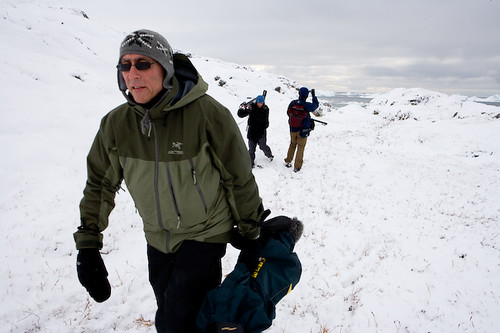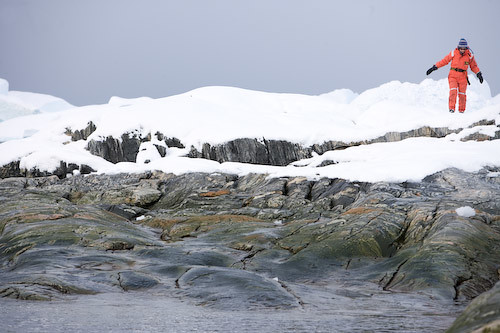Good news this morning – A new software CD is on its way to us with the latecomers of the group! Once the artists had ventured ashore, we had a couple of hours of ship time to go and test out some solutions for the seafloor sampling. The fantastic news is that it worked! I’m sure you’ll hear all about it from Carol and Dave soon enough. Aside from the science bit, we’re on the edge of a massive iceberg field. These things are huge, I’ve never seen anything like it, and they’re pouring out of the fastest retreating glacier in Greenland at a rate of knots. The scenery is breathtaking and I’m off out to see some more of it before we start another survey line. Hope all’s well back home! :o)
Read more about the previous days…
Listening to radio an interviewer ask their interviewee “describe the experience for the listener”. Description is all the listener needs, imagination does the rest. “well…” comes the reply “its just too beautiful for words”. The answer makes me want to rip out the interviewees tongue and slap them with it. The pursuit of description engages and overcomes the possibility of failure (to describe). If something is worth pursuing it means it matters. Ergo “it’s just too beautiful for words” causes things to disappear. You think I am taking this too far. Good. Then we are on the same page.
Continue reading
Our Second Mate has a fondness for the phrase: You have not seen what I have seen. This delivered ominously in a rich Russian voice. I think he’s probably right and am keen to keep things that way. But on Monday, after a walk through snow-wrought hills, we topped a level and before us swept miles of glacier debris in graded chunks, with the larger ones leading to the glacier itself, some 30 km upfjord. The sky was doing its usual “I can do this, and have you seen me do this, and then there’s this” routine. Words were a bit redundant so we stood looking out and talking about really unrelated things to keep calm. The record industry, Battenberg cakes, Sarah Palin, Michael Palin.
Then off we waddled in our Thinsulate symphonies on another walk led by our Inuit guide Ludvig, twisting through icy swampish land, heading downwards this time. Lemn pointed out a scene of polar gorgeousness and what a great picture that would be. I agreed: it didn’t make a bad reality either.
Continue reading

Photo by Nathan Gallagher
Success! We started the day with a sail up to the Jakobshavn Isbrae ice field, created by the grounding of icebergs from the glacier against a recessional moraine.
The glacier itself “flows” approximately 38m per day. However it only calves every 2 – 3 weeks according to local knowledge. This combination – fast flow rates and long periods between calving events results in very large bergs being discharged – see some of the attached photos!
Continue reading
Two standard responses to the problem of global warming are that either it’s not really happening or, if it is, there’s nothing we can do about it now so why not leave all the lights on? Well, it is happening, and the sooner we tame our energy emissions, the sooner the earth can return to being habitable for the citizens and other creatures of the 22nd century. Time is unlikely to stop when we die, it just seems that way sometimes. It’s true that we on this Cape Farewell expedition used aviation fuel and diesel to get here, but we will take the story back with us and spread it like butter on the toast of our item-rich society. As the scientists aboard research the effects of ice-melt on the ocean bed, and trace the possible mutation of the Gulf-stream through salination tests, we artists are being exposed to a landscape that cannot fail to affect our work.
Continue reading
On our fourth day aboard the Grigoriy Mikheev, we wake among icebergs. A mysterious magical kingdom: distant grey bergs are ghostly portals to the land of the dead, while near us the ice gives off an eerie blue light. Two whales lead us for a while. We disembark for several hours in a tranquil bay on the edge of the Ilulissat glacier’s ice-field. Amidst rock and ice, it’s touching to see signs of life – grasses, birdsong, and bilberries underfoot creating bloodstains in the snow.

Continue reading
Today as breakfast ended we were treated to a spectacular iceberg show as we journeyed down the ice fjord towards the front of the Jakobshavn Glacier Each berg more beautiful than the one that came before, you couldn’t help but feel in awe that this happens every day, that the ‘show’ wasn’t for our benefit, merely something we were lucky enough to stumble upon. I found myself stood on deck in my birkenstocks unable to turn away from everything before me. And as I sit here typing this blog on my bunk bed, I begin to wonder – did I actually see what I think I saw?
Continue reading
Pass through the icebergs coming off the Ilulissat glacier – it produces the largest icebergs in the northern hemisphere. The glacier’s retreat has been accelerating markedly across the last fifty years, making it one of the easy reference points for climate change storytelling. This is one of the place journalists practice the green virtue of recycling as they re-tread the same stories time and again.
Read on and more of Joe’s posts, and his colleagues’ responses, on the Science, Technology and Nature Blog.

Walking on ‘Little Eqe’ near the mouth of Ilulissat Kangia.

Director Peter Gilbert and documentary crew Zak Piper and Adam Singer film as the group climbs Little Eqe at the mouth of the glacier named Ilulissat Kangia (Danish name – Jacobshavn Glacier).
This morning I walked across the fresh snow with a gas cylinder in my arms, containing 6kg of CO2. I took it across the unspoiled snow field of the Jakobshavn Fjord until I found what, to my eyes, was a wonderful place.
From a little hill I could see massive icebergs impassably floating by, some of them breaking up from time to time with a loud bang. The sea below was deep grey, which made the icebergs stand up in all their beauty and fragility. The sky was a merge of pale grey and cerulean with a yellow glow just behind the skyline. Lichen and small berry plants could be felt under the powdery snow as I walked by. I thought this is perfect!
Continue reading









